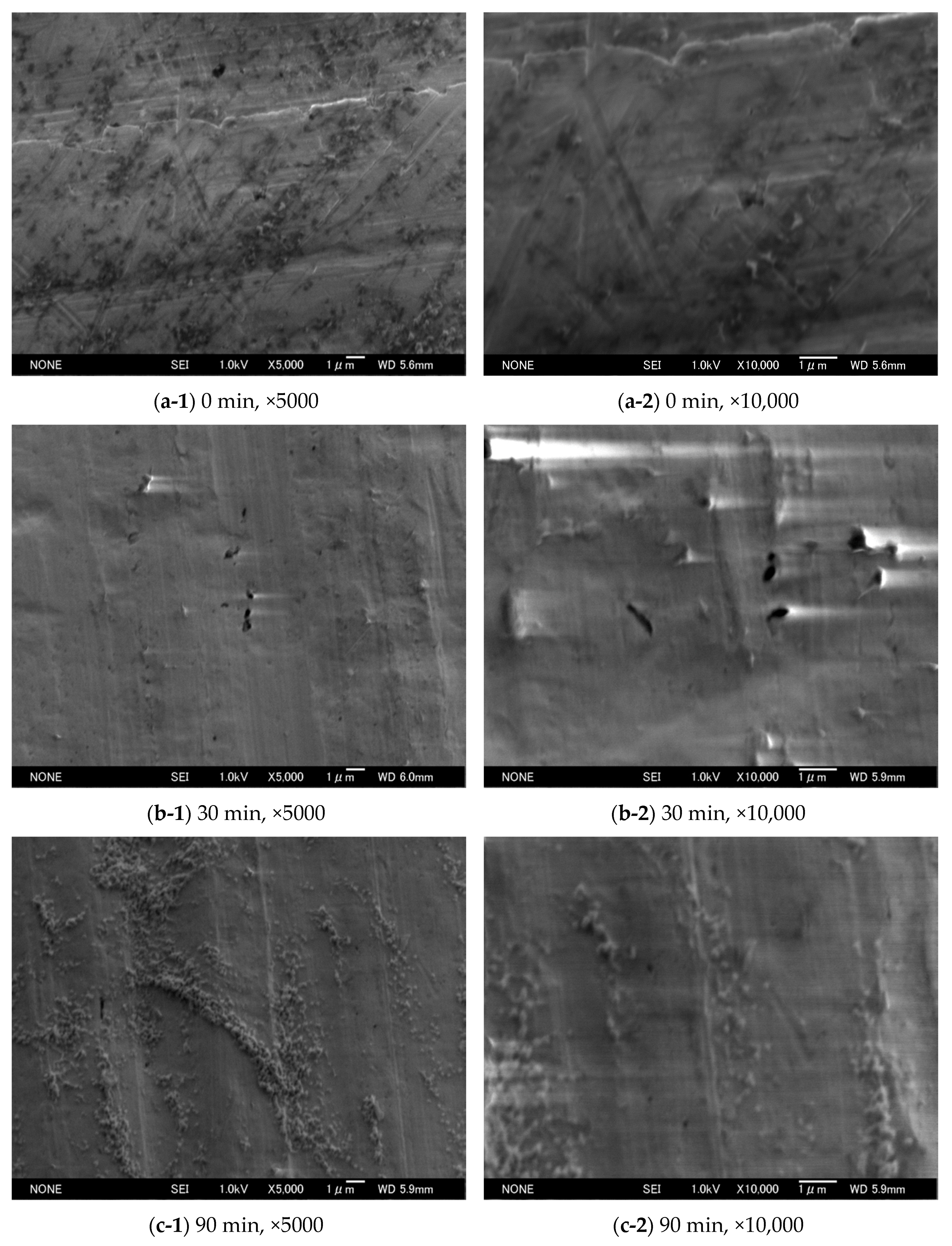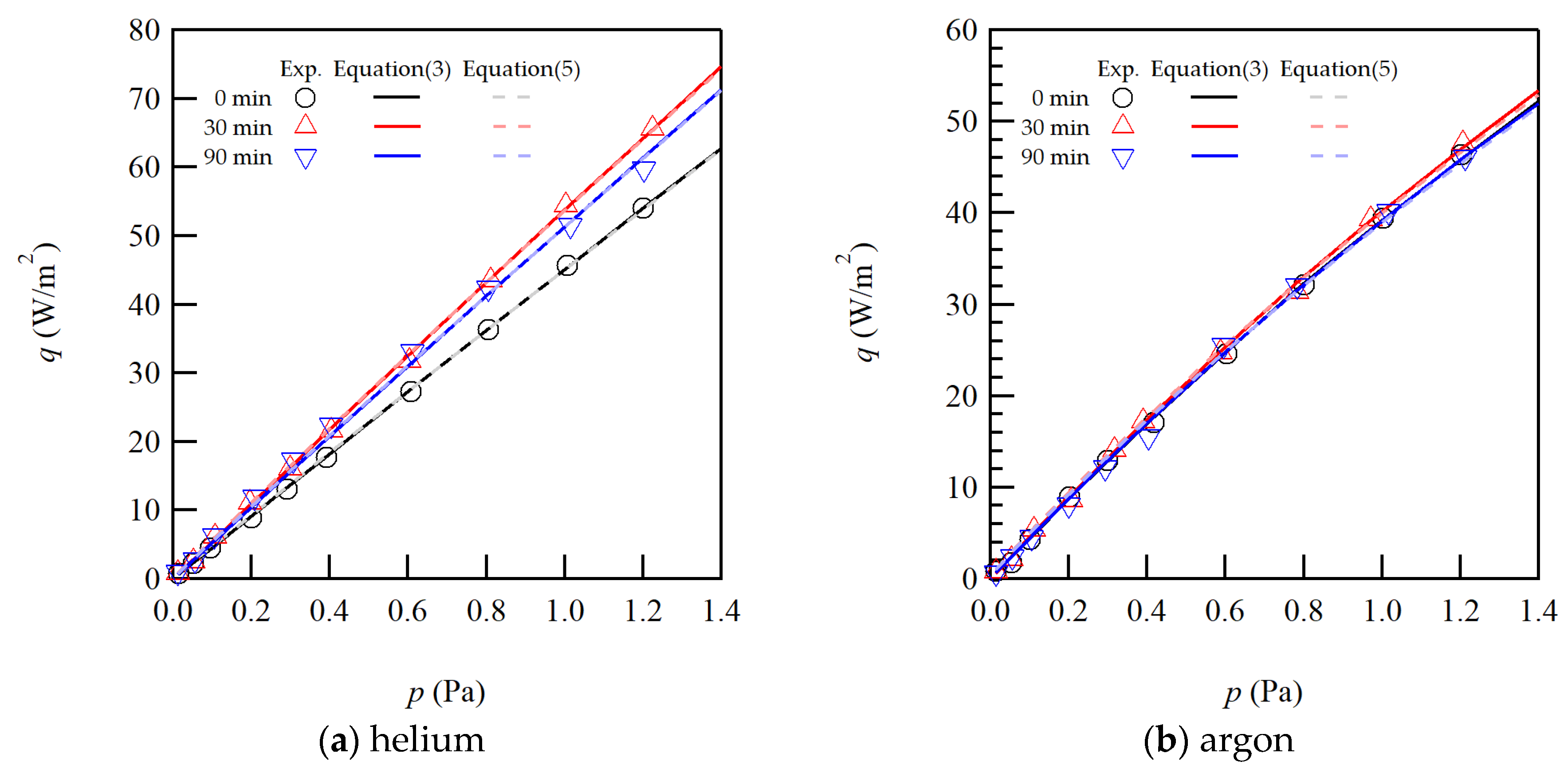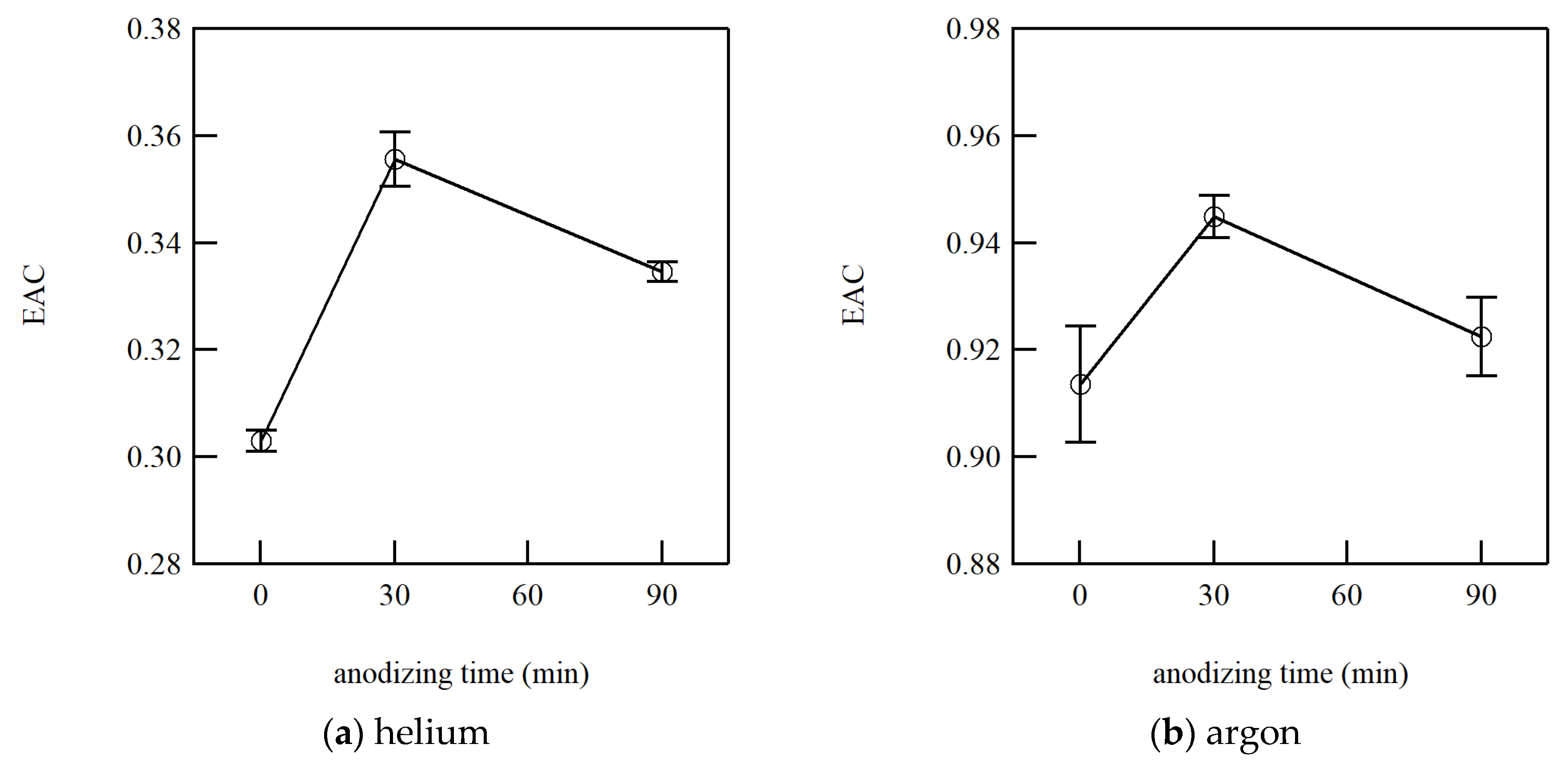Measurement of Heat Transfer from Anodic Oxide Film on Aluminum in High Knudsen Number Flows
Abstract
1. Introduction
2. Materials and Methods
2.1. Sample Surfaces
2.2. Method
2.3. Setup
3. Results and Discussions
3.1. Heat Flux
3.2. Energy Accommodation Coefficient
4. Conclusions
Author Contributions
Funding
Acknowledgments
Conflicts of Interest
References
- Goodman, F.O.; Wachman, H.Y. Dynamic of Gas-Surface Scattering; Academic: New York, NY, USA, 1976. [Google Scholar]
- Saxena, S.C.; Joshi, R.K. Thermal Accommodation and Adsorption Coefficients of Gases; Hemisphere: New York, NY, USA, 1989. [Google Scholar]
- Sharipov, F. Rarefied Gas Dynamics: Fundamentals for Research and Practice; Wiley-VCH: Berlin, Germany, 2006. [Google Scholar]
- Trott, W.M.; Castañeda, J.N.; Torczynski, J.R.; Gallis, M.A.; Rader, D.J. An experimental assembly for precise measurement of thermal accommodation coefficients. Rev. Sci. Inst. 2011, 82, 035120. [Google Scholar] [CrossRef] [PubMed]
- Ono, S. Structure and Growth Mechanism of Porous Anodic Oxide Films -Anodizing of Aluminum and Magnesium-. Hyomen Kagaku 1998, 19, 790–798. (In Japanese) [Google Scholar] [CrossRef][Green Version]
- Uchiyama, T.; Isoyama, E.; Otsuka, T. Surface treatment of aluminum. J. Jpn. Inst. Light Met. 1980, 30, 592–605. (In Japanese) [Google Scholar] [CrossRef]
- Yamaguchi, H.; Imai, T.; Iwai, T.; Kondo, A.; Matsuda, Y.; Niimi, T. Measurement of thermal accommodation coefficients using a simplified system in a concentric sphere shells configuration. J. Vac. Sci. Technol. A 2014, 32, 061602. [Google Scholar] [CrossRef]
- Yamaguchi, H.; Ho, M.T.; Matsuda, Y.; Niimi, T.; Graur, I. Conductive heat transfer in a gas confined between two concentric spheres: From free-molecular to continuum flow regime. Int. J. Heat Mass Transf. 2017, 108, 1527–1534. [Google Scholar] [CrossRef]
- Yamaguchi, H.; Hosoi, J.; Matsuda, Y.; Niimi, T. Measurement of conductive heat transfer through rarefied binary gas mixtures. Vacuum 2019, 160, 164–170. [Google Scholar] [CrossRef]
- Springer, G.S. Heat transfer in rarefied gases. In Advanced in Heat Transfer; Irvine, T.F., Harnett, J.P., Eds.; Academic Press: New York, NY, USA, 1971; Volume 7, pp. 163–218. [Google Scholar]
- Sherman, F.S. A survey of experimental results and methods for the transitional regime of rarefied gas dynamics. In Rarefied Gas Dynamics, Proceedings of the Third International Symposium on Rarefied Gas Dynamics, Paris, France, 26–30 June 1962; Academic Press: New York, NY, USA, 1963; pp. 228–260. [Google Scholar]
- Rumble, J.R., Jr.; Lide, D.R.; Bruno, T.J. CRC Handbook of Chemistry and Physics; CRC Press: Boca Raton, FL, USA, 2017. [Google Scholar]




| Used Equation | Gas Species | 0 Min | 30 Min | 90 Min |
|---|---|---|---|---|
| Equation (3) | Helium | 0.3049 ± 0.0020 | 0.3582 ± 0.0051 | 0.3369 ± 0.0018 |
| Argon | 0.9347 ± 0.0115 | 0.9675 ± 0.0039 | 0.9440 ± 0.0077 | |
| Equation (5) | Helium | 0.3030 ± 0.0020 | 0.3556 ± 0.0051 | 0.3346 ± 0.0018 |
| Argon | 0.9135 ± 0.0108 | 0.9449 ± 0.0039 | 0.9225 ± 0.0074 |
© 2020 by the authors. Licensee MDPI, Basel, Switzerland. This article is an open access article distributed under the terms and conditions of the Creative Commons Attribution (CC BY) license (http://creativecommons.org/licenses/by/4.0/).
Share and Cite
Yamaguchi, H.; Kito, K. Measurement of Heat Transfer from Anodic Oxide Film on Aluminum in High Knudsen Number Flows. Micromachines 2020, 11, 234. https://doi.org/10.3390/mi11030234
Yamaguchi H, Kito K. Measurement of Heat Transfer from Anodic Oxide Film on Aluminum in High Knudsen Number Flows. Micromachines. 2020; 11(3):234. https://doi.org/10.3390/mi11030234
Chicago/Turabian StyleYamaguchi, Hiroki, and Kenji Kito. 2020. "Measurement of Heat Transfer from Anodic Oxide Film on Aluminum in High Knudsen Number Flows" Micromachines 11, no. 3: 234. https://doi.org/10.3390/mi11030234
APA StyleYamaguchi, H., & Kito, K. (2020). Measurement of Heat Transfer from Anodic Oxide Film on Aluminum in High Knudsen Number Flows. Micromachines, 11(3), 234. https://doi.org/10.3390/mi11030234





